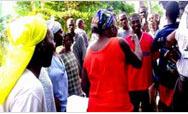In Cusco, the ancient capital of the Incas and modern Peruvian metropolis of over 350,000, a typical market vendor produces an average of 132 pounds of solid waste everyday - totaling 310 metric tons daily city-wide. Of the waste, 40% was regularly dumped into the rivers of Vilcanota and Huatanay, causing terrible health, sanitary, and pollution problems.
USAID funded the Reference Center for Appropriate Technology and Environmental Management, a solid waste disposal and recycling center project, to help the municipality develop a system for waste recycling and disposal. The program installed and/or improved solid waste collection facilities, basic sanitary services, and water in all twelve markets in and around the City of Cusco. A waste segregation pilot plant was built to sort inorganic waste produced by markets, schools, public institutions, and participating neighborhoods for recycling and resale.
The program also raised awareness of the importance of waste management, and created a training program involving key sectors within the City of Cusco and the surrounding districts. More than 1,500 market vendors, police members, schools and institutions were trained to improve hygiene practices and learn to classify different types of waste in order to make the management process more effective. An association of handicapped youth was trained and its members are now employed at the pilot sorting plant which was inaugurated in August 21, 2003. Their appreciation for their paying jobs is mirrored in their enthusiasm for the project and their willingness to work harder. “We wished the conveyer belt went faster, we are able to do it,” a trained disabled youth commented.
|


